Reflecting on Privacy, Security, and Ethics for NGO Clients
VerifiedAdded on 2023/06/03
|15
|3979
|469
Essay
AI Summary
This essay provides a comprehensive reflection on the personal and ethical implications of privacy and security concerning NGO clients, particularly in the context of government divestment and the use of digital IDs. It discusses the ethical issues faced by information professionals in processing personal data, emphasizing the importance of truth, freedom, and human rights. The essay also addresses security threats in online environments like privilege escalation, viruses, worms, and spyware, and offers recommendations for privacy protection on mobile devices, including strong password policies and account lockouts. It highlights the need for NGOs to protect client information, ensure data confidentiality, and implement robust security measures to prevent cyberattacks and data breaches, especially when handling sensitive information in cloud environments.
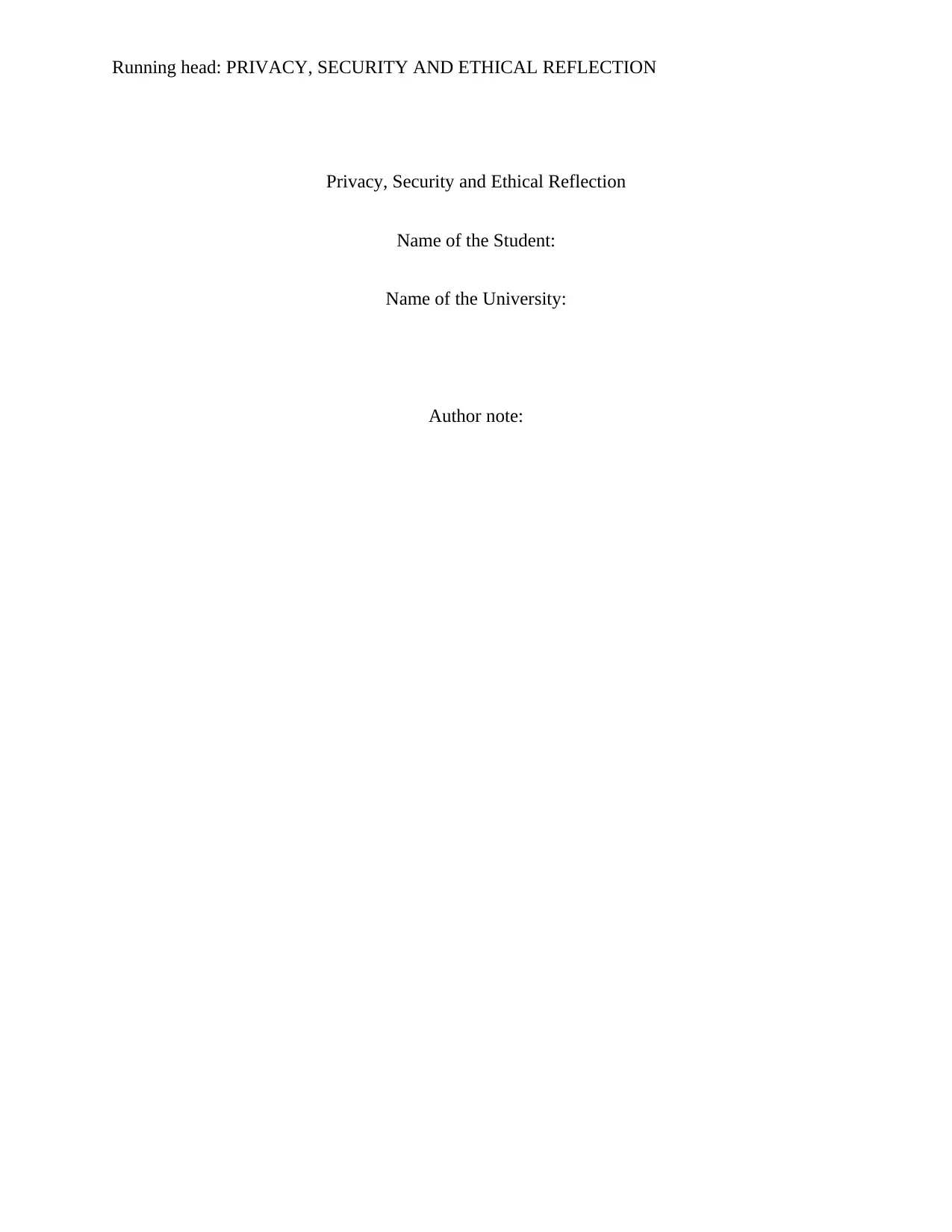
Running head: PRIVACY, SECURITY AND ETHICAL REFLECTION
Privacy, Security and Ethical Reflection
Name of the Student:
Name of the University:
Author note:
Privacy, Security and Ethical Reflection
Name of the Student:
Name of the University:
Author note:
Paraphrase This Document
Need a fresh take? Get an instant paraphrase of this document with our AI Paraphraser
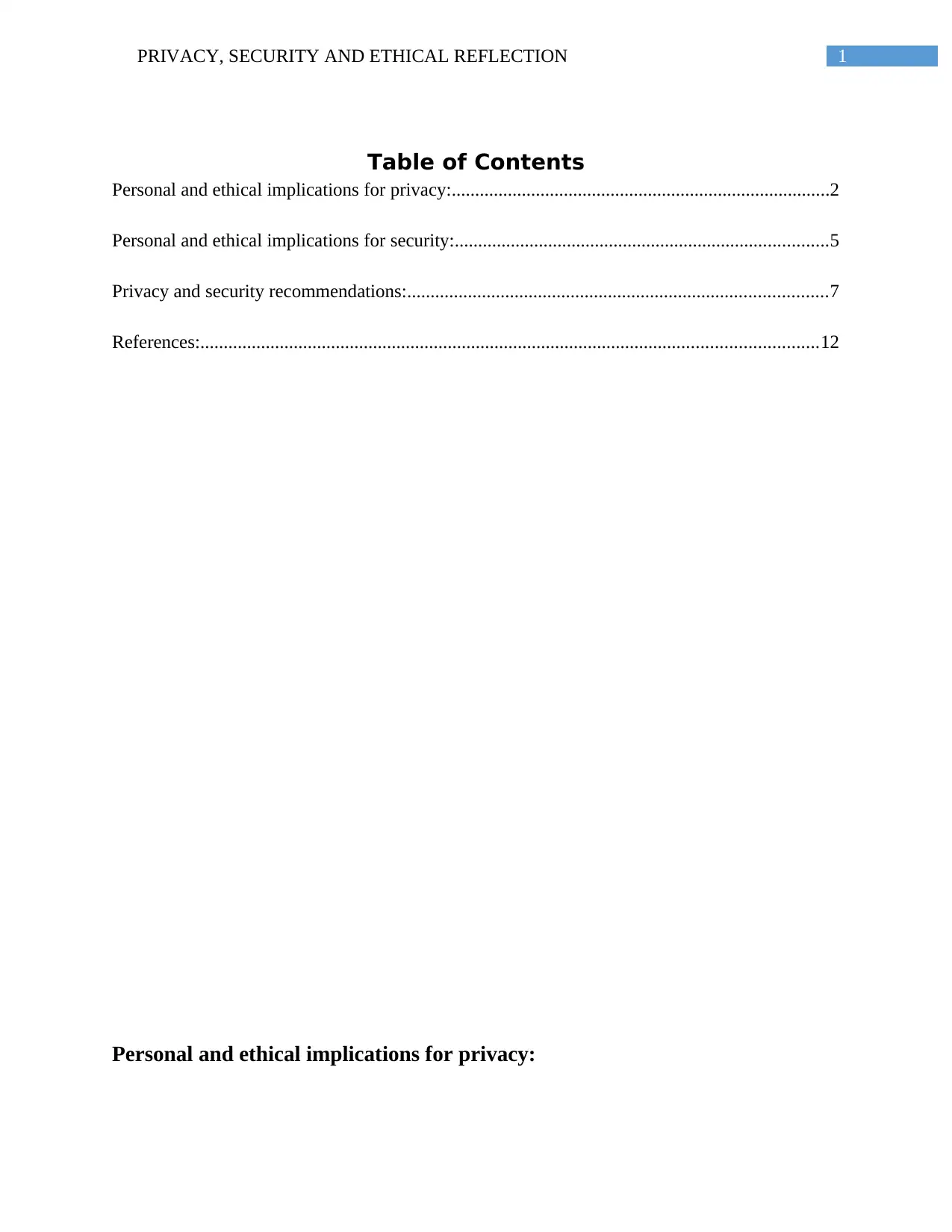
1PRIVACY, SECURITY AND ETHICAL REFLECTION
Table of Contents
Personal and ethical implications for privacy:.................................................................................2
Personal and ethical implications for security:................................................................................5
Privacy and security recommendations:..........................................................................................7
References:....................................................................................................................................12
Personal and ethical implications for privacy:
Table of Contents
Personal and ethical implications for privacy:.................................................................................2
Personal and ethical implications for security:................................................................................5
Privacy and security recommendations:..........................................................................................7
References:....................................................................................................................................12
Personal and ethical implications for privacy:
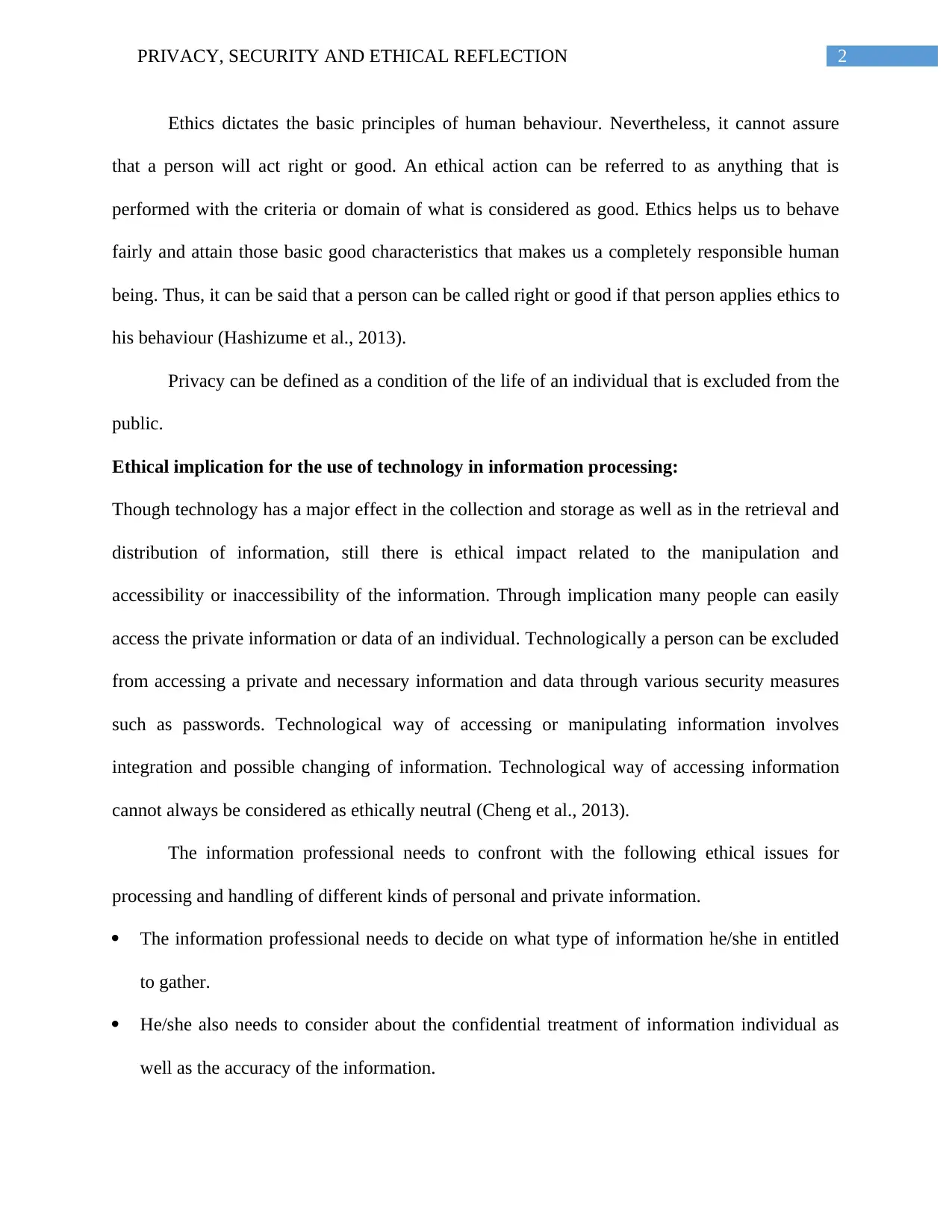
2PRIVACY, SECURITY AND ETHICAL REFLECTION
Ethics dictates the basic principles of human behaviour. Nevertheless, it cannot assure
that a person will act right or good. An ethical action can be referred to as anything that is
performed with the criteria or domain of what is considered as good. Ethics helps us to behave
fairly and attain those basic good characteristics that makes us a completely responsible human
being. Thus, it can be said that a person can be called right or good if that person applies ethics to
his behaviour (Hashizume et al., 2013).
Privacy can be defined as a condition of the life of an individual that is excluded from the
public.
Ethical implication for the use of technology in information processing:
Though technology has a major effect in the collection and storage as well as in the retrieval and
distribution of information, still there is ethical impact related to the manipulation and
accessibility or inaccessibility of the information. Through implication many people can easily
access the private information or data of an individual. Technologically a person can be excluded
from accessing a private and necessary information and data through various security measures
such as passwords. Technological way of accessing or manipulating information involves
integration and possible changing of information. Technological way of accessing information
cannot always be considered as ethically neutral (Cheng et al., 2013).
The information professional needs to confront with the following ethical issues for
processing and handling of different kinds of personal and private information.
The information professional needs to decide on what type of information he/she in entitled
to gather.
He/she also needs to consider about the confidential treatment of information individual as
well as the accuracy of the information.
Ethics dictates the basic principles of human behaviour. Nevertheless, it cannot assure
that a person will act right or good. An ethical action can be referred to as anything that is
performed with the criteria or domain of what is considered as good. Ethics helps us to behave
fairly and attain those basic good characteristics that makes us a completely responsible human
being. Thus, it can be said that a person can be called right or good if that person applies ethics to
his behaviour (Hashizume et al., 2013).
Privacy can be defined as a condition of the life of an individual that is excluded from the
public.
Ethical implication for the use of technology in information processing:
Though technology has a major effect in the collection and storage as well as in the retrieval and
distribution of information, still there is ethical impact related to the manipulation and
accessibility or inaccessibility of the information. Through implication many people can easily
access the private information or data of an individual. Technologically a person can be excluded
from accessing a private and necessary information and data through various security measures
such as passwords. Technological way of accessing or manipulating information involves
integration and possible changing of information. Technological way of accessing information
cannot always be considered as ethically neutral (Cheng et al., 2013).
The information professional needs to confront with the following ethical issues for
processing and handling of different kinds of personal and private information.
The information professional needs to decide on what type of information he/she in entitled
to gather.
He/she also needs to consider about the confidential treatment of information individual as
well as the accuracy of the information.
⊘ This is a preview!⊘
Do you want full access?
Subscribe today to unlock all pages.

Trusted by 1+ million students worldwide
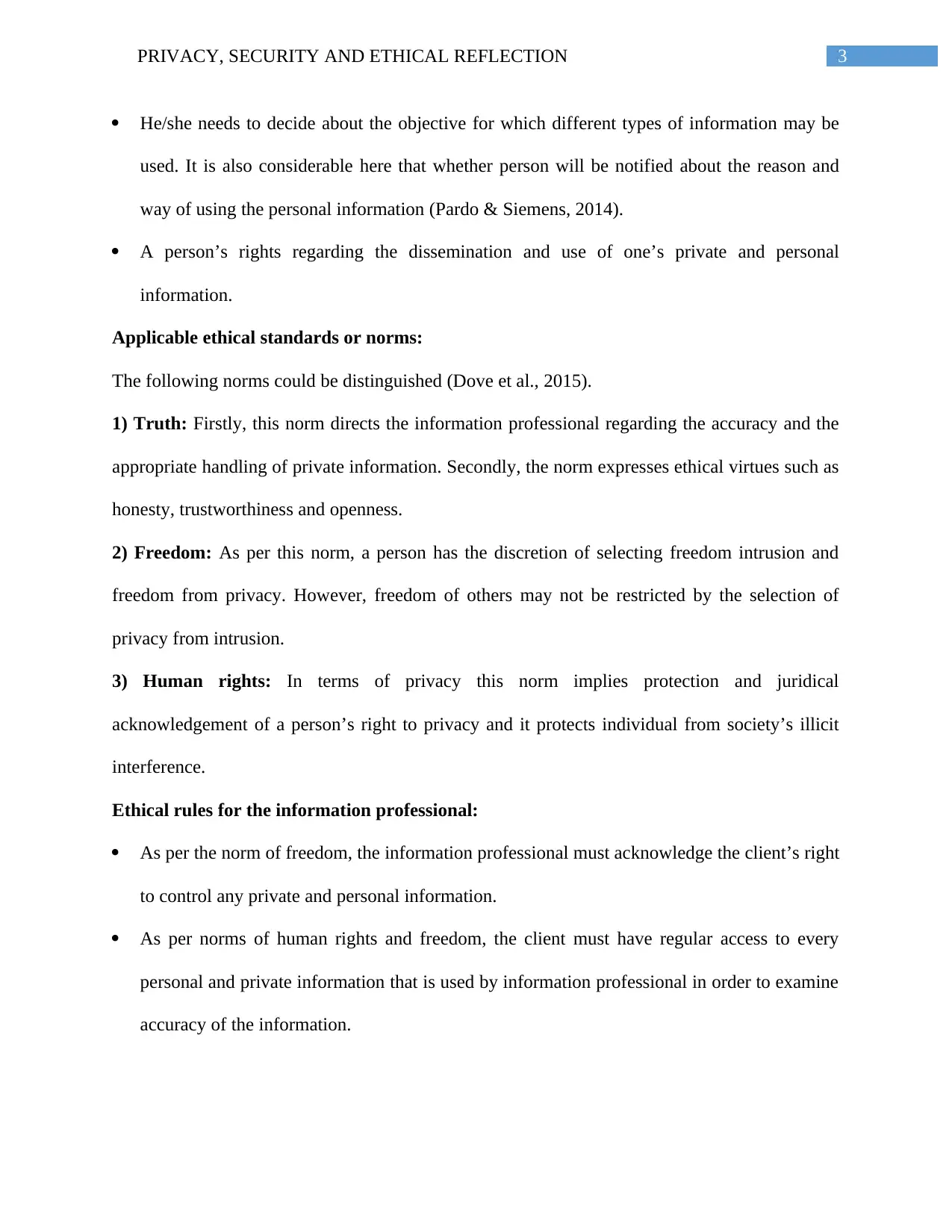
3PRIVACY, SECURITY AND ETHICAL REFLECTION
He/she needs to decide about the objective for which different types of information may be
used. It is also considerable here that whether person will be notified about the reason and
way of using the personal information (Pardo & Siemens, 2014).
A person’s rights regarding the dissemination and use of one’s private and personal
information.
Applicable ethical standards or norms:
The following norms could be distinguished (Dove et al., 2015).
1) Truth: Firstly, this norm directs the information professional regarding the accuracy and the
appropriate handling of private information. Secondly, the norm expresses ethical virtues such as
honesty, trustworthiness and openness.
2) Freedom: As per this norm, a person has the discretion of selecting freedom intrusion and
freedom from privacy. However, freedom of others may not be restricted by the selection of
privacy from intrusion.
3) Human rights: In terms of privacy this norm implies protection and juridical
acknowledgement of a person’s right to privacy and it protects individual from society’s illicit
interference.
Ethical rules for the information professional:
As per the norm of freedom, the information professional must acknowledge the client’s right
to control any private and personal information.
As per norms of human rights and freedom, the client must have regular access to every
personal and private information that is used by information professional in order to examine
accuracy of the information.
He/she needs to decide about the objective for which different types of information may be
used. It is also considerable here that whether person will be notified about the reason and
way of using the personal information (Pardo & Siemens, 2014).
A person’s rights regarding the dissemination and use of one’s private and personal
information.
Applicable ethical standards or norms:
The following norms could be distinguished (Dove et al., 2015).
1) Truth: Firstly, this norm directs the information professional regarding the accuracy and the
appropriate handling of private information. Secondly, the norm expresses ethical virtues such as
honesty, trustworthiness and openness.
2) Freedom: As per this norm, a person has the discretion of selecting freedom intrusion and
freedom from privacy. However, freedom of others may not be restricted by the selection of
privacy from intrusion.
3) Human rights: In terms of privacy this norm implies protection and juridical
acknowledgement of a person’s right to privacy and it protects individual from society’s illicit
interference.
Ethical rules for the information professional:
As per the norm of freedom, the information professional must acknowledge the client’s right
to control any private and personal information.
As per norms of human rights and freedom, the client must have regular access to every
personal and private information that is used by information professional in order to examine
accuracy of the information.
Paraphrase This Document
Need a fresh take? Get an instant paraphrase of this document with our AI Paraphraser
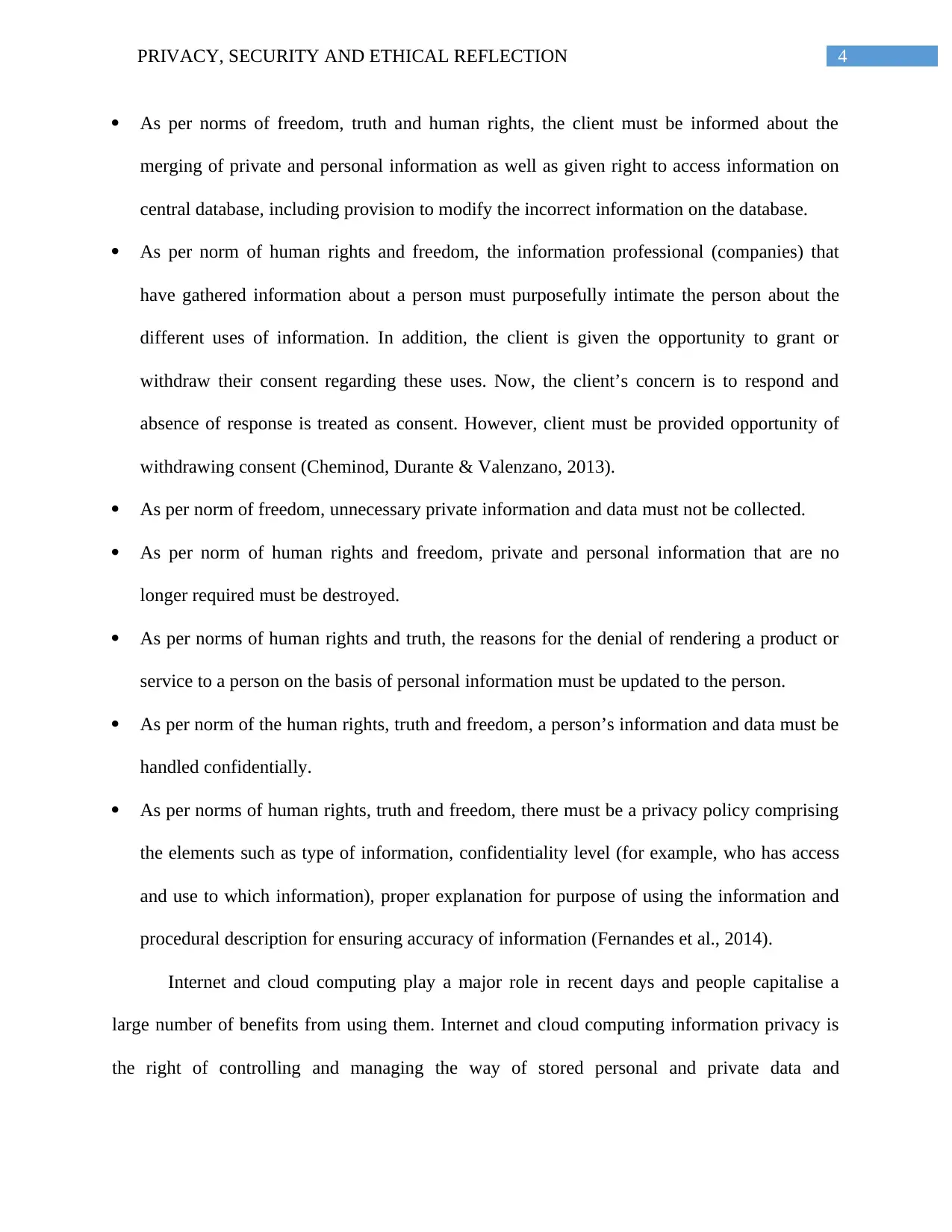
4PRIVACY, SECURITY AND ETHICAL REFLECTION
As per norms of freedom, truth and human rights, the client must be informed about the
merging of private and personal information as well as given right to access information on
central database, including provision to modify the incorrect information on the database.
As per norm of human rights and freedom, the information professional (companies) that
have gathered information about a person must purposefully intimate the person about the
different uses of information. In addition, the client is given the opportunity to grant or
withdraw their consent regarding these uses. Now, the client’s concern is to respond and
absence of response is treated as consent. However, client must be provided opportunity of
withdrawing consent (Cheminod, Durante & Valenzano, 2013).
As per norm of freedom, unnecessary private information and data must not be collected.
As per norm of human rights and freedom, private and personal information that are no
longer required must be destroyed.
As per norms of human rights and truth, the reasons for the denial of rendering a product or
service to a person on the basis of personal information must be updated to the person.
As per norm of the human rights, truth and freedom, a person’s information and data must be
handled confidentially.
As per norms of human rights, truth and freedom, there must be a privacy policy comprising
the elements such as type of information, confidentiality level (for example, who has access
and use to which information), proper explanation for purpose of using the information and
procedural description for ensuring accuracy of information (Fernandes et al., 2014).
Internet and cloud computing play a major role in recent days and people capitalise a
large number of benefits from using them. Internet and cloud computing information privacy is
the right of controlling and managing the way of stored personal and private data and
As per norms of freedom, truth and human rights, the client must be informed about the
merging of private and personal information as well as given right to access information on
central database, including provision to modify the incorrect information on the database.
As per norm of human rights and freedom, the information professional (companies) that
have gathered information about a person must purposefully intimate the person about the
different uses of information. In addition, the client is given the opportunity to grant or
withdraw their consent regarding these uses. Now, the client’s concern is to respond and
absence of response is treated as consent. However, client must be provided opportunity of
withdrawing consent (Cheminod, Durante & Valenzano, 2013).
As per norm of freedom, unnecessary private information and data must not be collected.
As per norm of human rights and freedom, private and personal information that are no
longer required must be destroyed.
As per norms of human rights and truth, the reasons for the denial of rendering a product or
service to a person on the basis of personal information must be updated to the person.
As per norm of the human rights, truth and freedom, a person’s information and data must be
handled confidentially.
As per norms of human rights, truth and freedom, there must be a privacy policy comprising
the elements such as type of information, confidentiality level (for example, who has access
and use to which information), proper explanation for purpose of using the information and
procedural description for ensuring accuracy of information (Fernandes et al., 2014).
Internet and cloud computing play a major role in recent days and people capitalise a
large number of benefits from using them. Internet and cloud computing information privacy is
the right of controlling and managing the way of stored personal and private data and
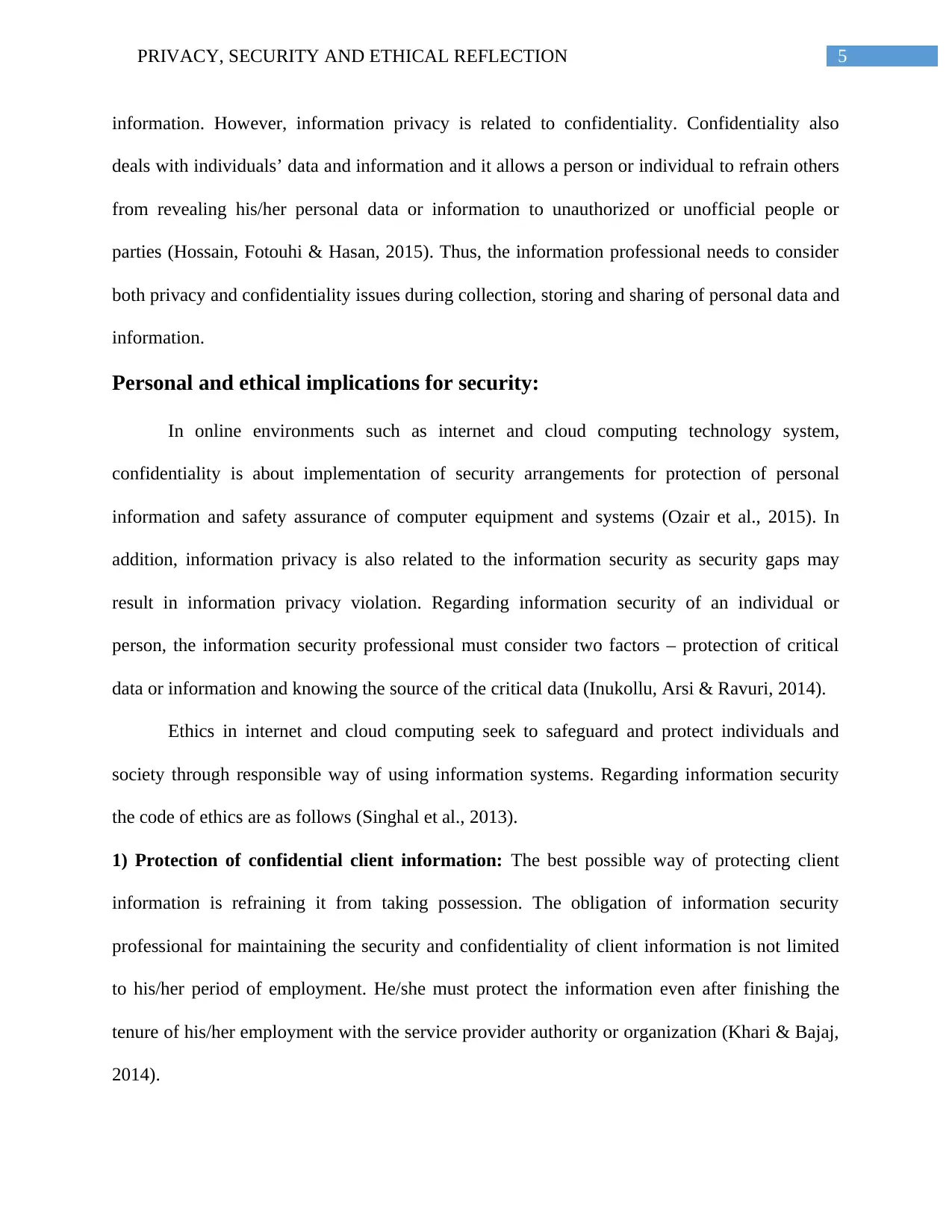
5PRIVACY, SECURITY AND ETHICAL REFLECTION
information. However, information privacy is related to confidentiality. Confidentiality also
deals with individuals’ data and information and it allows a person or individual to refrain others
from revealing his/her personal data or information to unauthorized or unofficial people or
parties (Hossain, Fotouhi & Hasan, 2015). Thus, the information professional needs to consider
both privacy and confidentiality issues during collection, storing and sharing of personal data and
information.
Personal and ethical implications for security:
In online environments such as internet and cloud computing technology system,
confidentiality is about implementation of security arrangements for protection of personal
information and safety assurance of computer equipment and systems (Ozair et al., 2015). In
addition, information privacy is also related to the information security as security gaps may
result in information privacy violation. Regarding information security of an individual or
person, the information security professional must consider two factors – protection of critical
data or information and knowing the source of the critical data (Inukollu, Arsi & Ravuri, 2014).
Ethics in internet and cloud computing seek to safeguard and protect individuals and
society through responsible way of using information systems. Regarding information security
the code of ethics are as follows (Singhal et al., 2013).
1) Protection of confidential client information: The best possible way of protecting client
information is refraining it from taking possession. The obligation of information security
professional for maintaining the security and confidentiality of client information is not limited
to his/her period of employment. He/she must protect the information even after finishing the
tenure of his/her employment with the service provider authority or organization (Khari & Bajaj,
2014).
information. However, information privacy is related to confidentiality. Confidentiality also
deals with individuals’ data and information and it allows a person or individual to refrain others
from revealing his/her personal data or information to unauthorized or unofficial people or
parties (Hossain, Fotouhi & Hasan, 2015). Thus, the information professional needs to consider
both privacy and confidentiality issues during collection, storing and sharing of personal data and
information.
Personal and ethical implications for security:
In online environments such as internet and cloud computing technology system,
confidentiality is about implementation of security arrangements for protection of personal
information and safety assurance of computer equipment and systems (Ozair et al., 2015). In
addition, information privacy is also related to the information security as security gaps may
result in information privacy violation. Regarding information security of an individual or
person, the information security professional must consider two factors – protection of critical
data or information and knowing the source of the critical data (Inukollu, Arsi & Ravuri, 2014).
Ethics in internet and cloud computing seek to safeguard and protect individuals and
society through responsible way of using information systems. Regarding information security
the code of ethics are as follows (Singhal et al., 2013).
1) Protection of confidential client information: The best possible way of protecting client
information is refraining it from taking possession. The obligation of information security
professional for maintaining the security and confidentiality of client information is not limited
to his/her period of employment. He/she must protect the information even after finishing the
tenure of his/her employment with the service provider authority or organization (Khari & Bajaj,
2014).
⊘ This is a preview!⊘
Do you want full access?
Subscribe today to unlock all pages.

Trusted by 1+ million students worldwide

6PRIVACY, SECURITY AND ETHICAL REFLECTION
2) Personal data of individual: The information security professional must not reveal any
information or data about the former and/or existing employee or member of the organization or
service provider authority without prior consent of the employee or member.
Security threat:
A security threat is referred to as any malicious event or action that aims to interrupt the
integrity of personal or organization computer systems. The basic intention of this is
compromising data for exploitation purpose. The targeted data can be sensitive type such as
passwords, list of contacts, credit card information and so on. The following security threats are
normally encountered in online environments such as internet and cloud computing (Komninos,
Philippou & Pitsillides, 2014).
1) Privilege escalation: Here bugs in the software programs are exploited to gain access control
to certain higher privileged resources that can detour security controls.
2) Virus: It is referred to as a software program that is capable of replicating itself and infecting
other computer systems. Normally, transmission of virus occurs over networks as well as by
means of universal serial bus (USB) drives and other movable media (Smith & Wong, 2016).
3) Worm: It is particular virus type which unlike a virus does not modify system files, instead it
consumes large memory or disk space by replicating itself innumerable times. Worms slow down
and crashes the system.
4) Trojan or trojan horses: These are programs that disguise themselves as normal and safe
applications with the purpose of allowing hacker to remotely access a system. The infected
computer system in turn may be used as section of denial of service (DOS) attack which may
result in data theft. For instance, keystroke logger trojan can capture sensitive information such
as passwords, credit card numbers (White, Fisch & Pooch, 2017).
2) Personal data of individual: The information security professional must not reveal any
information or data about the former and/or existing employee or member of the organization or
service provider authority without prior consent of the employee or member.
Security threat:
A security threat is referred to as any malicious event or action that aims to interrupt the
integrity of personal or organization computer systems. The basic intention of this is
compromising data for exploitation purpose. The targeted data can be sensitive type such as
passwords, list of contacts, credit card information and so on. The following security threats are
normally encountered in online environments such as internet and cloud computing (Komninos,
Philippou & Pitsillides, 2014).
1) Privilege escalation: Here bugs in the software programs are exploited to gain access control
to certain higher privileged resources that can detour security controls.
2) Virus: It is referred to as a software program that is capable of replicating itself and infecting
other computer systems. Normally, transmission of virus occurs over networks as well as by
means of universal serial bus (USB) drives and other movable media (Smith & Wong, 2016).
3) Worm: It is particular virus type which unlike a virus does not modify system files, instead it
consumes large memory or disk space by replicating itself innumerable times. Worms slow down
and crashes the system.
4) Trojan or trojan horses: These are programs that disguise themselves as normal and safe
applications with the purpose of allowing hacker to remotely access a system. The infected
computer system in turn may be used as section of denial of service (DOS) attack which may
result in data theft. For instance, keystroke logger trojan can capture sensitive information such
as passwords, credit card numbers (White, Fisch & Pooch, 2017).
Paraphrase This Document
Need a fresh take? Get an instant paraphrase of this document with our AI Paraphraser
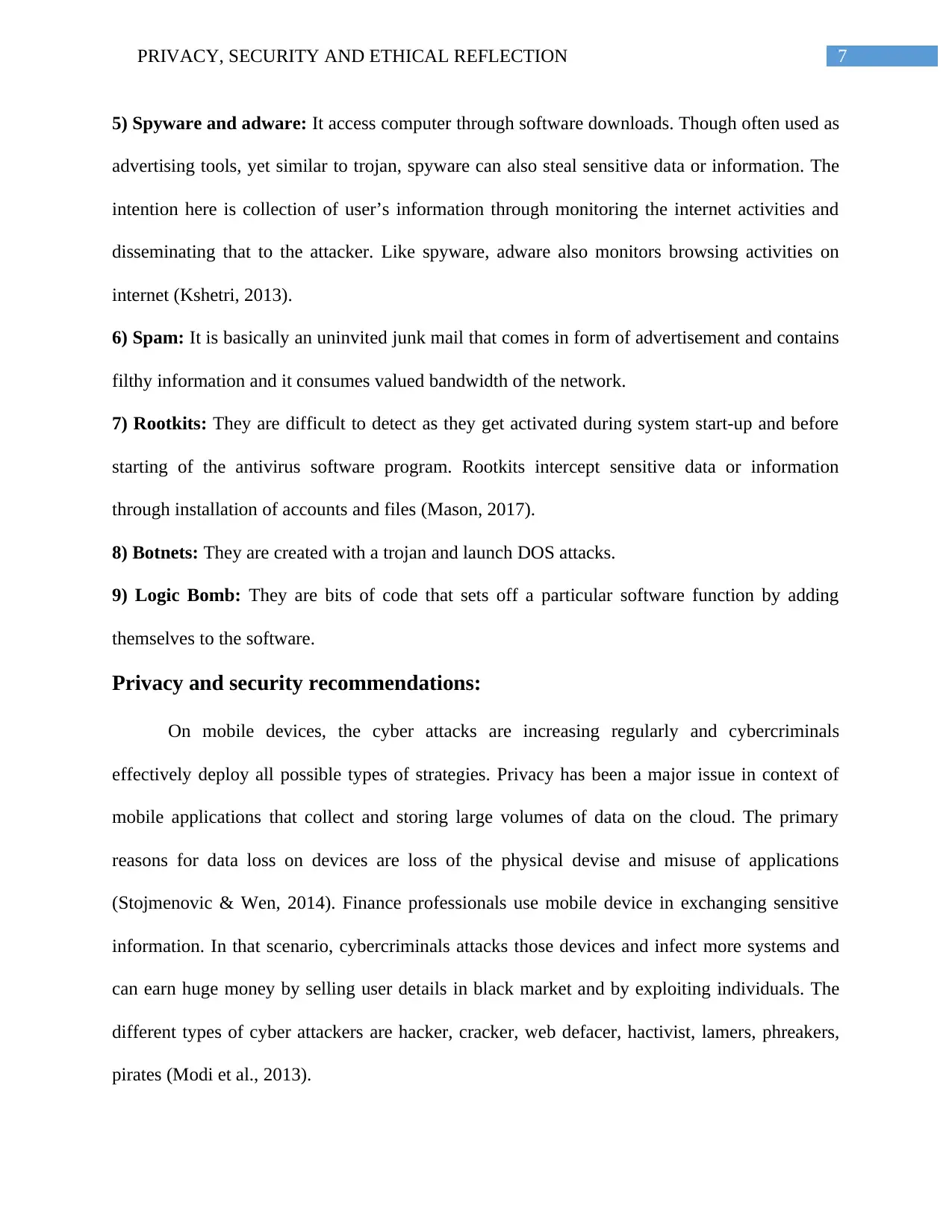
7PRIVACY, SECURITY AND ETHICAL REFLECTION
5) Spyware and adware: It access computer through software downloads. Though often used as
advertising tools, yet similar to trojan, spyware can also steal sensitive data or information. The
intention here is collection of user’s information through monitoring the internet activities and
disseminating that to the attacker. Like spyware, adware also monitors browsing activities on
internet (Kshetri, 2013).
6) Spam: It is basically an uninvited junk mail that comes in form of advertisement and contains
filthy information and it consumes valued bandwidth of the network.
7) Rootkits: They are difficult to detect as they get activated during system start-up and before
starting of the antivirus software program. Rootkits intercept sensitive data or information
through installation of accounts and files (Mason, 2017).
8) Botnets: They are created with a trojan and launch DOS attacks.
9) Logic Bomb: They are bits of code that sets off a particular software function by adding
themselves to the software.
Privacy and security recommendations:
On mobile devices, the cyber attacks are increasing regularly and cybercriminals
effectively deploy all possible types of strategies. Privacy has been a major issue in context of
mobile applications that collect and storing large volumes of data on the cloud. The primary
reasons for data loss on devices are loss of the physical devise and misuse of applications
(Stojmenovic & Wen, 2014). Finance professionals use mobile device in exchanging sensitive
information. In that scenario, cybercriminals attacks those devices and infect more systems and
can earn huge money by selling user details in black market and by exploiting individuals. The
different types of cyber attackers are hacker, cracker, web defacer, hactivist, lamers, phreakers,
pirates (Modi et al., 2013).
5) Spyware and adware: It access computer through software downloads. Though often used as
advertising tools, yet similar to trojan, spyware can also steal sensitive data or information. The
intention here is collection of user’s information through monitoring the internet activities and
disseminating that to the attacker. Like spyware, adware also monitors browsing activities on
internet (Kshetri, 2013).
6) Spam: It is basically an uninvited junk mail that comes in form of advertisement and contains
filthy information and it consumes valued bandwidth of the network.
7) Rootkits: They are difficult to detect as they get activated during system start-up and before
starting of the antivirus software program. Rootkits intercept sensitive data or information
through installation of accounts and files (Mason, 2017).
8) Botnets: They are created with a trojan and launch DOS attacks.
9) Logic Bomb: They are bits of code that sets off a particular software function by adding
themselves to the software.
Privacy and security recommendations:
On mobile devices, the cyber attacks are increasing regularly and cybercriminals
effectively deploy all possible types of strategies. Privacy has been a major issue in context of
mobile applications that collect and storing large volumes of data on the cloud. The primary
reasons for data loss on devices are loss of the physical devise and misuse of applications
(Stojmenovic & Wen, 2014). Finance professionals use mobile device in exchanging sensitive
information. In that scenario, cybercriminals attacks those devices and infect more systems and
can earn huge money by selling user details in black market and by exploiting individuals. The
different types of cyber attackers are hacker, cracker, web defacer, hactivist, lamers, phreakers,
pirates (Modi et al., 2013).

8PRIVACY, SECURITY AND ETHICAL REFLECTION
In computer systems and mobile devices, the most normal form authentication methods
are verification of passwords and user IDs or user names. On the internet, different types of
applications are available for password guessing activities. The attacker or the intruder is
required to point a particular application of password guesser at a website or computer. After that
the application start the process of password guessing in the target device or system and it keeps
trying generally used user IDs or user names and huge numbers of passwords until the attacker or
intruder’s system gain access to the target device or system. This type of attacking method is
referred to as brute force hacking. The following methods are applied to encounter this type of
attack (Kim, 2014).
Account lockouts: This feature disable and locks the account after the user exceeds
maximum number of valid login attempts.
Account renaming: Any account that are built into operating systems (OS), applications or
devices such as administrator must be renamed or changed from their default values.
Password policy: This feature allows to establish policy that requires passwords to satisfy
complexity needs and ensures that they are changed periodically. In addition, this policy can
be imposed within the application or OS.
Recommendation for privacy protection in mobile devices:
1) Using passcode: During passcode setting, the user must use the exact security measures as
he/she would have done it or do it on any other device. The user strictly must not share his/her
passcode in any case. The user must not reuse passwords from other devices or websites. It is
preferable that user must use pin as passcode instead of swipe patterns as possibility of guessing
a pattern is much higher than guessing a pin.
In computer systems and mobile devices, the most normal form authentication methods
are verification of passwords and user IDs or user names. On the internet, different types of
applications are available for password guessing activities. The attacker or the intruder is
required to point a particular application of password guesser at a website or computer. After that
the application start the process of password guessing in the target device or system and it keeps
trying generally used user IDs or user names and huge numbers of passwords until the attacker or
intruder’s system gain access to the target device or system. This type of attacking method is
referred to as brute force hacking. The following methods are applied to encounter this type of
attack (Kim, 2014).
Account lockouts: This feature disable and locks the account after the user exceeds
maximum number of valid login attempts.
Account renaming: Any account that are built into operating systems (OS), applications or
devices such as administrator must be renamed or changed from their default values.
Password policy: This feature allows to establish policy that requires passwords to satisfy
complexity needs and ensures that they are changed periodically. In addition, this policy can
be imposed within the application or OS.
Recommendation for privacy protection in mobile devices:
1) Using passcode: During passcode setting, the user must use the exact security measures as
he/she would have done it or do it on any other device. The user strictly must not share his/her
passcode in any case. The user must not reuse passwords from other devices or websites. It is
preferable that user must use pin as passcode instead of swipe patterns as possibility of guessing
a pattern is much higher than guessing a pin.
⊘ This is a preview!⊘
Do you want full access?
Subscribe today to unlock all pages.

Trusted by 1+ million students worldwide

9PRIVACY, SECURITY AND ETHICAL REFLECTION
2) Selective use of applications: The user must go through trusted application store to verify
reviews and feedback about any new application. The user must be specifically cautious with the
financial application.
3) Avoid accessing suspicious links: The use must perform proper research work before
accessing any link.
4) Enable remote wiping: This feature allows a user to erase the data of his/her device in case
the device got stolen or lost.
5) Maintain software update: Software updates can patch privacy and security loopholes that
are found by the users. Hence, the user must regularly update software on his/her device.
6) Using security applications: Though installing and using security software user can protect
his/her privacy against any unknown threats or annoys.
7) Staying off the open Wi-Fi networks: The user must strictly stay off his/her Wi-Fi networks
on device as there are chances of transmission of user passwords and credit card information by
the malicious hotspots without his/her knowledge.
8) Recording the International Mobile Equipment Identity (IMEI): IMEI of a mobile device
is a fifteen digit serial number that can help in speeding up the device back to user.
9) Taking regular backup of the device: The user must regularly backup his/her data as the
operating system (OS) update on device can result in data loss.
10) Protecting subscribers identity module (SIM) card data: Before handover the device to
anybody for selling or repairing purpose the user must remove both the SIM card and memory
card.
Recommendation for security protection in mobile devices (Yang et al., 2013):
2) Selective use of applications: The user must go through trusted application store to verify
reviews and feedback about any new application. The user must be specifically cautious with the
financial application.
3) Avoid accessing suspicious links: The use must perform proper research work before
accessing any link.
4) Enable remote wiping: This feature allows a user to erase the data of his/her device in case
the device got stolen or lost.
5) Maintain software update: Software updates can patch privacy and security loopholes that
are found by the users. Hence, the user must regularly update software on his/her device.
6) Using security applications: Though installing and using security software user can protect
his/her privacy against any unknown threats or annoys.
7) Staying off the open Wi-Fi networks: The user must strictly stay off his/her Wi-Fi networks
on device as there are chances of transmission of user passwords and credit card information by
the malicious hotspots without his/her knowledge.
8) Recording the International Mobile Equipment Identity (IMEI): IMEI of a mobile device
is a fifteen digit serial number that can help in speeding up the device back to user.
9) Taking regular backup of the device: The user must regularly backup his/her data as the
operating system (OS) update on device can result in data loss.
10) Protecting subscribers identity module (SIM) card data: Before handover the device to
anybody for selling or repairing purpose the user must remove both the SIM card and memory
card.
Recommendation for security protection in mobile devices (Yang et al., 2013):
Paraphrase This Document
Need a fresh take? Get an instant paraphrase of this document with our AI Paraphraser
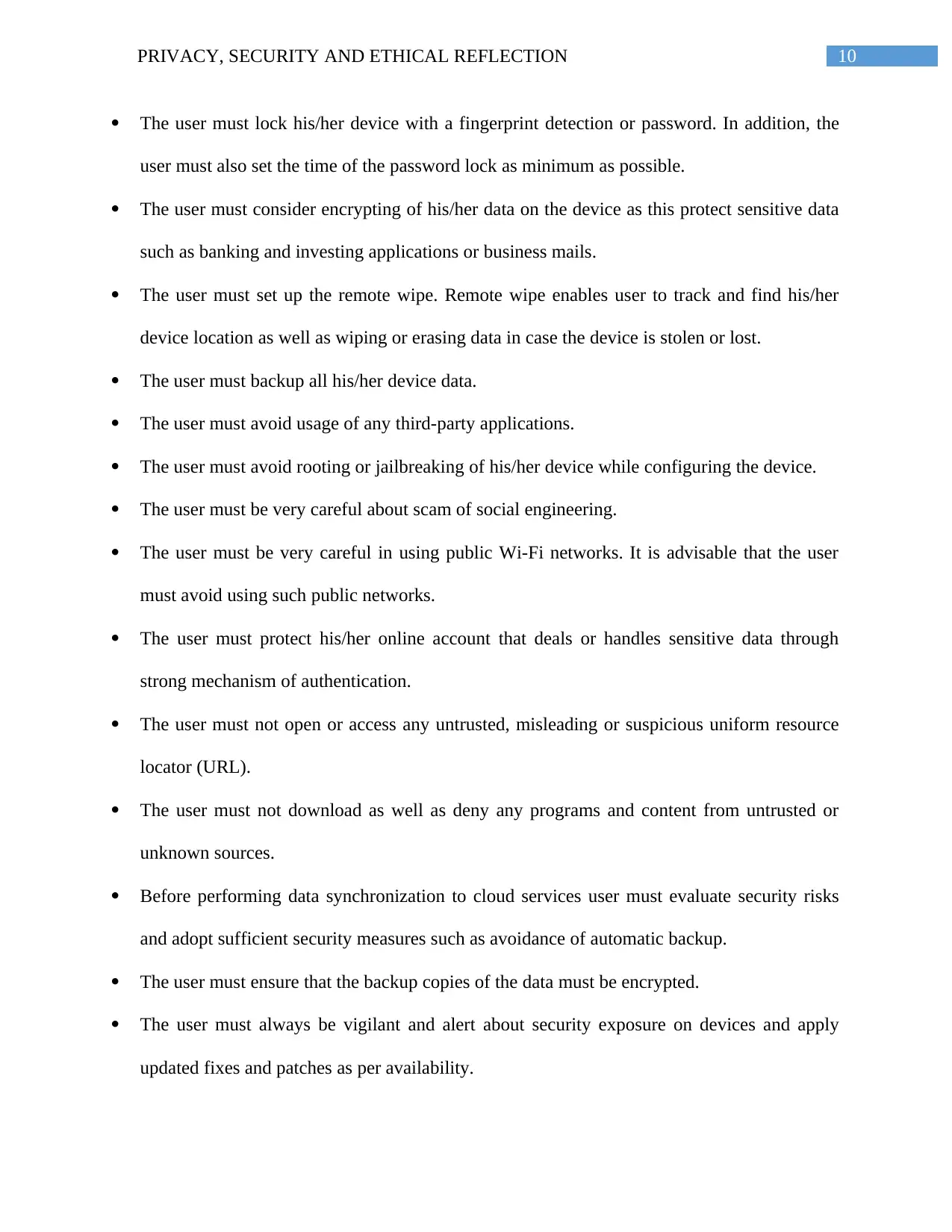
10PRIVACY, SECURITY AND ETHICAL REFLECTION
The user must lock his/her device with a fingerprint detection or password. In addition, the
user must also set the time of the password lock as minimum as possible.
The user must consider encrypting of his/her data on the device as this protect sensitive data
such as banking and investing applications or business mails.
The user must set up the remote wipe. Remote wipe enables user to track and find his/her
device location as well as wiping or erasing data in case the device is stolen or lost.
The user must backup all his/her device data.
The user must avoid usage of any third-party applications.
The user must avoid rooting or jailbreaking of his/her device while configuring the device.
The user must be very careful about scam of social engineering.
The user must be very careful in using public Wi-Fi networks. It is advisable that the user
must avoid using such public networks.
The user must protect his/her online account that deals or handles sensitive data through
strong mechanism of authentication.
The user must not open or access any untrusted, misleading or suspicious uniform resource
locator (URL).
The user must not download as well as deny any programs and content from untrusted or
unknown sources.
Before performing data synchronization to cloud services user must evaluate security risks
and adopt sufficient security measures such as avoidance of automatic backup.
The user must ensure that the backup copies of the data must be encrypted.
The user must always be vigilant and alert about security exposure on devices and apply
updated fixes and patches as per availability.
The user must lock his/her device with a fingerprint detection or password. In addition, the
user must also set the time of the password lock as minimum as possible.
The user must consider encrypting of his/her data on the device as this protect sensitive data
such as banking and investing applications or business mails.
The user must set up the remote wipe. Remote wipe enables user to track and find his/her
device location as well as wiping or erasing data in case the device is stolen or lost.
The user must backup all his/her device data.
The user must avoid usage of any third-party applications.
The user must avoid rooting or jailbreaking of his/her device while configuring the device.
The user must be very careful about scam of social engineering.
The user must be very careful in using public Wi-Fi networks. It is advisable that the user
must avoid using such public networks.
The user must protect his/her online account that deals or handles sensitive data through
strong mechanism of authentication.
The user must not open or access any untrusted, misleading or suspicious uniform resource
locator (URL).
The user must not download as well as deny any programs and content from untrusted or
unknown sources.
Before performing data synchronization to cloud services user must evaluate security risks
and adopt sufficient security measures such as avoidance of automatic backup.
The user must ensure that the backup copies of the data must be encrypted.
The user must always be vigilant and alert about security exposure on devices and apply
updated fixes and patches as per availability.
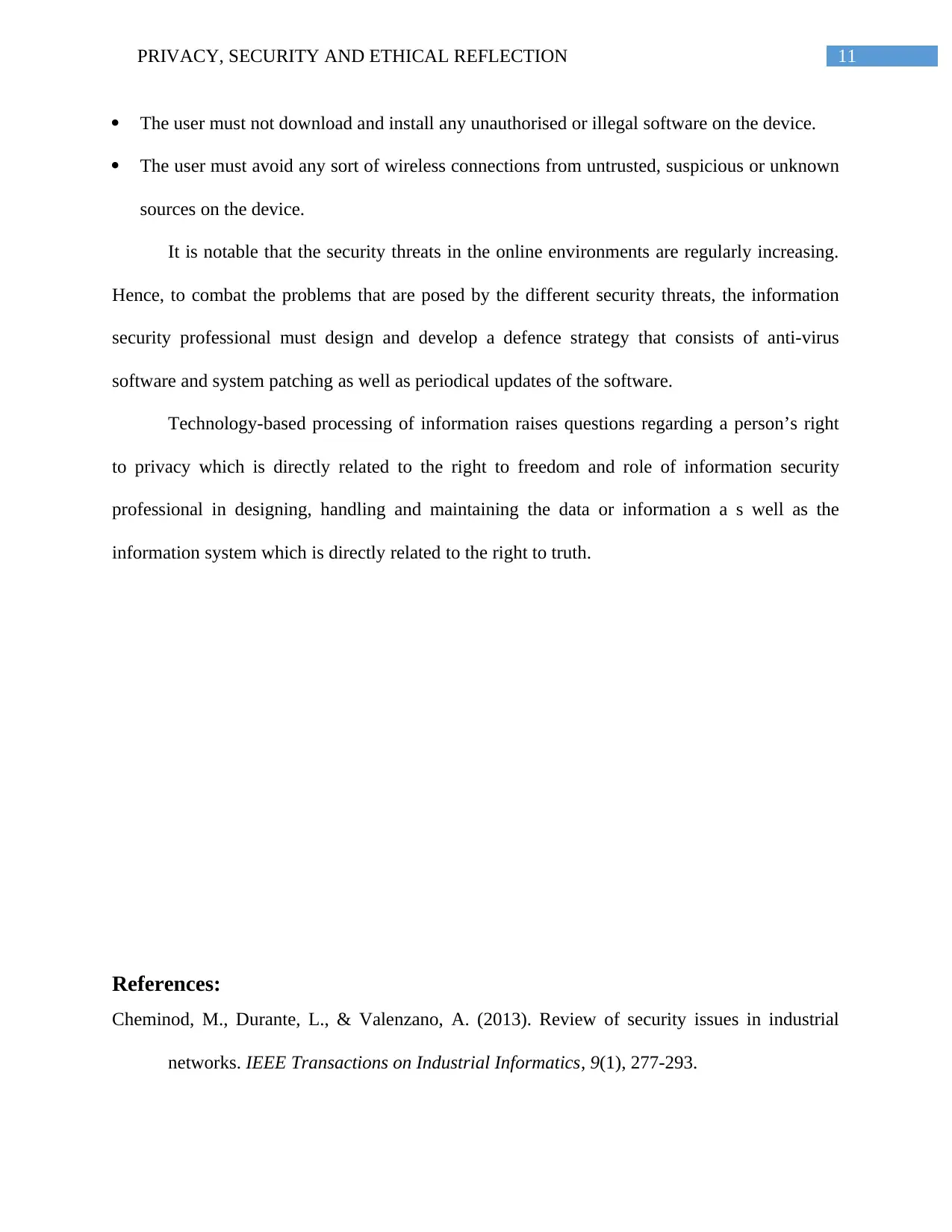
11PRIVACY, SECURITY AND ETHICAL REFLECTION
The user must not download and install any unauthorised or illegal software on the device.
The user must avoid any sort of wireless connections from untrusted, suspicious or unknown
sources on the device.
It is notable that the security threats in the online environments are regularly increasing.
Hence, to combat the problems that are posed by the different security threats, the information
security professional must design and develop a defence strategy that consists of anti-virus
software and system patching as well as periodical updates of the software.
Technology-based processing of information raises questions regarding a person’s right
to privacy which is directly related to the right to freedom and role of information security
professional in designing, handling and maintaining the data or information a s well as the
information system which is directly related to the right to truth.
References:
Cheminod, M., Durante, L., & Valenzano, A. (2013). Review of security issues in industrial
networks. IEEE Transactions on Industrial Informatics, 9(1), 277-293.
The user must not download and install any unauthorised or illegal software on the device.
The user must avoid any sort of wireless connections from untrusted, suspicious or unknown
sources on the device.
It is notable that the security threats in the online environments are regularly increasing.
Hence, to combat the problems that are posed by the different security threats, the information
security professional must design and develop a defence strategy that consists of anti-virus
software and system patching as well as periodical updates of the software.
Technology-based processing of information raises questions regarding a person’s right
to privacy which is directly related to the right to freedom and role of information security
professional in designing, handling and maintaining the data or information a s well as the
information system which is directly related to the right to truth.
References:
Cheminod, M., Durante, L., & Valenzano, A. (2013). Review of security issues in industrial
networks. IEEE Transactions on Industrial Informatics, 9(1), 277-293.
⊘ This is a preview!⊘
Do you want full access?
Subscribe today to unlock all pages.

Trusted by 1+ million students worldwide
1 out of 15
Related Documents
Your All-in-One AI-Powered Toolkit for Academic Success.
+13062052269
info@desklib.com
Available 24*7 on WhatsApp / Email
![[object Object]](/_next/static/media/star-bottom.7253800d.svg)
Unlock your academic potential
Copyright © 2020–2025 A2Z Services. All Rights Reserved. Developed and managed by ZUCOL.





